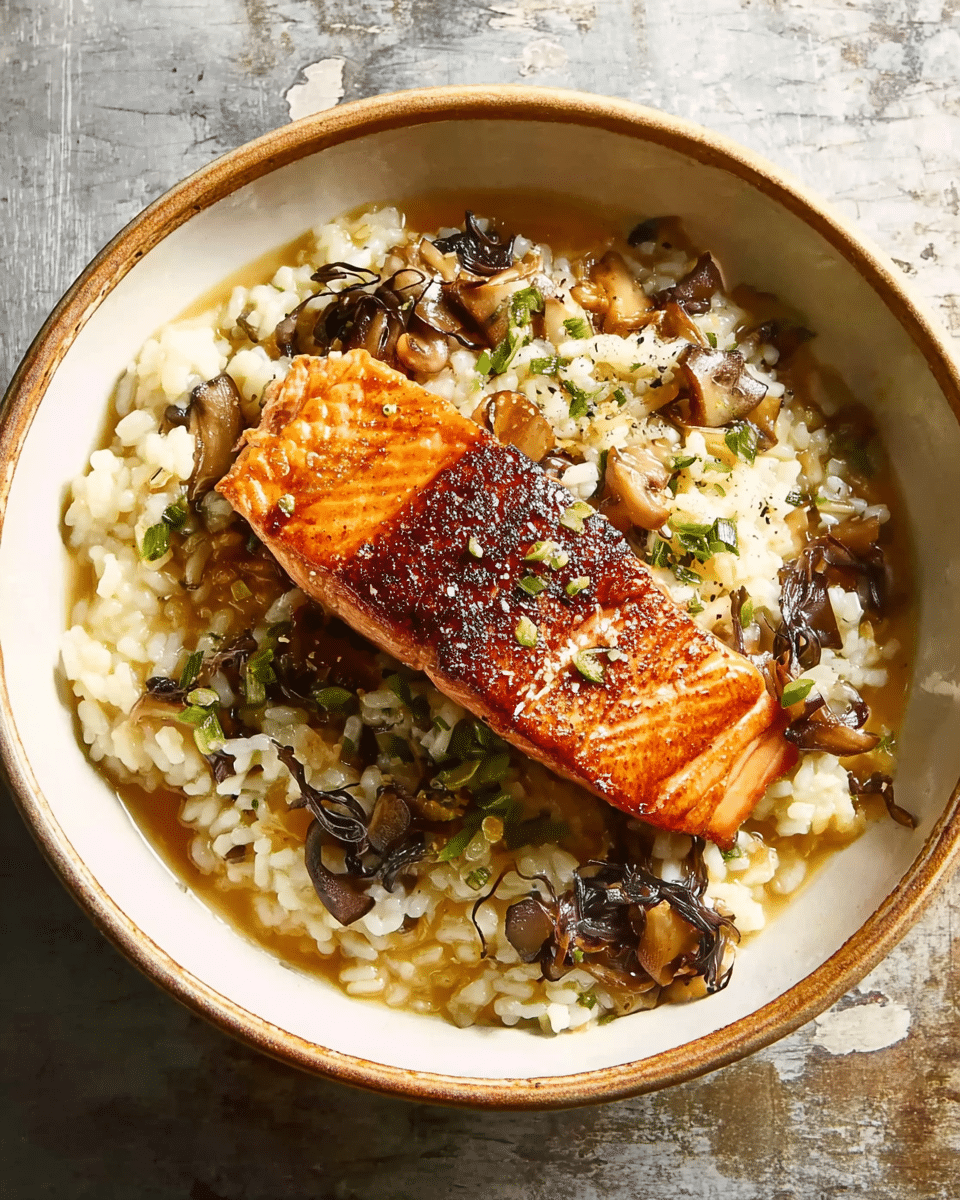This Japanese-style risotto with seared salmon is a savory, comforting dish that combines umami-rich flavors from shiitake mushrooms, miso, and soy sauce, with the perfect texture of creamy risotto. The seared salmon, glazed with soy sauce and brown sugar, adds a crispy, flavorful topping to the risotto, making it a satisfying and elevated meal. It’s a fusion of comforting Italian risotto and Japanese-inspired flavors, ready in about 40 minutes!
Full Recipe:
Ingredients
For the Risotto:
-
3 tbsp olive oil (divided)
-
10.5 oz shiitake mushrooms, torn into pieces
-
1 tbsp low sodium soy sauce
-
1 small yellow onion, diced
-
1 celery stalk, diced
-
1 garlic clove, minced
-
1 cup rice (sushi rice or Arborio)
-
¼ cup dry white wine (or sake)
-
5 cups hot chicken broth
-
1 tbsp white miso paste
-
Black pepper (for serving)
-
Chives (for serving)
-
Sesame seeds (for serving)
For the Seared Salmon:
-
5 tbsp low sodium soy sauce
-
1 tbsp dry white wine
-
1 tsp brown sugar
-
4 skinless salmon fillets
-
1 tbsp olive oil
-
1 tbsp unsalted butter
Directions
-
Marinate the Salmon: In a shallow dish, mix soy sauce, white wine, and brown sugar. Add salmon fillets, coat both sides, and let marinate for 10-15 minutes.
-
Prepare the Risotto: Heat 1 tablespoon of olive oil in a large skillet over high heat. Add the shiitakes and cook until they release moisture. Add the remaining oil, then the soy sauce, and cook for another minute. Remove the mushrooms from the skillet.
-
Cook Vegetables and Rice: Lower the heat to medium-low. Add celery, onion, and garlic to the skillet and cook for 2 minutes until fragrant. Add the rice, toast for 1 minute, then deglaze with white wine. Let it simmer for 2 minutes while scraping the bottom of the skillet.
-
Simmer the Risotto: Gradually add chicken broth, 2 ladles at a time, stirring frequently, until the liquid is absorbed before adding more. Continue until the rice is nearly al dente (about 15 minutes). Stir in the cooked mushrooms, dissolve miso paste with some hot broth, and mix it into the risotto. Simmer for 5 more minutes, adding more broth if needed.
-
Sear the Salmon: In a nonstick skillet, heat olive oil and butter over medium-high heat. Add the salmon fillets and sear for 3-4 minutes per side until crispy and golden.
-
Serve: Serve the risotto in bowls, topped with the seared salmon. Garnish with black pepper, chives, and sesame seeds.
Nutrients
-
Calories: 627 kcal (per serving)
-
Carbohydrates: 46g
-
Protein: 42g
-
Fat: 29g
-
Saturated Fat: 6g
-
Polyunsaturated Fat: 6g
-
Monounsaturated Fat: 15g
-
-
Sodium: 1109mg
-
Potassium: 1227mg
-
Fiber: 3g
-
Sugar: 3g
-
Vitamin A: 164 IU
-
Vitamin C: 0.3mg
-
Calcium: 50mg
-
Iron: 3mg
The Fusion of Italian Risotto and Japanese Flavors
Risotto, a staple of Italian cuisine, is known for its creamy texture and comforting nature. The slow-cooking process, where broth is gradually added to the rice, allows the grains to release their starch, resulting in a rich and velvety dish. In this recipe, we take the traditional risotto and infuse it with Japanese-inspired ingredients, which introduces a whole new layer of complexity and flavor.
The use of shiitake mushrooms, soy sauce, miso paste, and sesame seeds makes this risotto distinctly Japanese. Shiitake mushrooms, with their earthy and slightly smoky flavor, are a common ingredient in Japanese cooking and pair perfectly with the creamy risotto. Miso paste, made from fermented soybeans, adds a savory, umami-rich depth to the dish, while the soy sauce contributes saltiness and complexity. These ingredients, combined with the traditional Italian risotto technique, create a dish that is both familiar and excitingly new.
The Importance of Seared Salmon
The seared salmon in this dish is not only a visually striking addition, but it also plays a key role in enhancing the overall flavor profile. Salmon is known for its rich, fatty texture and distinctive taste, making it an excellent choice to pair with the creamy risotto. The glaze made from soy sauce, white wine, and brown sugar adds a sweet and savory coating to the fish, creating a crispy exterior while keeping the inside tender and moist.
Seared salmon offers a contrast in texture to the soft and creamy risotto, providing a satisfying crunch that complements the dish’s overall richness. The crispy edges of the salmon fillets provide an extra layer of flavor and texture, making every bite a delightful experience. Furthermore, the salmon’s protein content adds a heartiness to the meal, making it a filling and well-rounded dish.
Cooking Techniques for the Perfect Risotto
Making risotto is all about patience and technique. The process requires gradually adding liquid to the rice, stirring frequently to allow the rice to release its starch, creating that signature creamy texture. In this recipe, the rice is first toasted in olive oil to bring out its nutty flavor, and then deglazed with white wine, which adds acidity and depth.
As the rice cooks, hot chicken broth is slowly added in small amounts. Each addition of broth must be absorbed by the rice before more liquid is added, ensuring that the risotto becomes perfectly creamy without being too soupy. The gradual addition of liquid is essential for achieving the desired consistency and texture in the risotto.
The key to perfect risotto lies in the balance of cooking time and liquid absorption. The rice should be tender but still slightly firm to the bite, a texture known as “al dente.” Once the rice reaches this stage, the cooked shiitake mushrooms are added, along with the dissolved miso paste. This step further enhances the umami flavor of the dish, ensuring that each bite is rich and flavorful.
The Role of Miso and Soy Sauce in Flavor
Miso and soy sauce are central to this dish’s unique flavor profile. Both ingredients are rich in umami, the savory fifth taste, which is a hallmark of Japanese cuisine. Miso paste, made from fermented soybeans, adds a depth of flavor to the risotto that cannot be achieved with traditional seasonings. Its salty, earthy taste enhances the natural flavors of the rice and vegetables, while also complementing the richness of the salmon.
Soy sauce, a staple of Japanese cooking, adds saltiness, acidity, and a hint of sweetness. In this recipe, the soy sauce is used not only to season the risotto but also to glaze the salmon. The soy sauce glaze caramelizes as the salmon sears, creating a crispy, flavorful crust. This combination of miso and soy sauce brings a balance of salty, sweet, and savory flavors, making the dish truly dynamic.
The Importance of the Glaze on the Salmon
The glaze on the salmon is a simple yet effective way to infuse the fish with flavor. The soy sauce, white wine, and brown sugar mixture is the perfect balance of salty, sweet, and slightly acidic, which helps to enhance the natural richness of the salmon. When the salmon is seared in the pan, the glaze caramelizes, creating a crispy, golden crust on the fish.
This caramelization process not only adds a satisfying crunch to the salmon but also deepens the flavor, creating a complex taste that perfectly complements the creamy risotto. The sweetness from the brown sugar balances out the salty soy sauce, ensuring that the fish is not overly salty while still being packed with flavor. The end result is a salmon fillet that is crispy on the outside, tender and moist on the inside, and infused with a beautiful balance of flavors.
Serving and Garnishing the Dish
Once the risotto and salmon are prepared, it’s time to plate the dish and add the finishing touches. The risotto is served in bowls, creating a creamy base for the seared salmon fillets to rest on top. The crispy salmon fillets not only add a delicious contrast in texture but also a pop of color, making the dish visually appealing.
To enhance the flavors further, the risotto is garnished with a sprinkle of black pepper, which adds a touch of spice and warmth. Chives and sesame seeds are then sprinkled on top for an added burst of freshness and crunch. The chives provide a mild onion flavor, while the sesame seeds contribute a nutty, toasted taste that complements the other ingredients. This simple yet elegant presentation ensures that the dish looks as good as it tastes.
Health Benefits of the Dish
Japanese-style risotto with seared salmon is a nutritious and well-balanced meal. Salmon is an excellent source of protein and omega-3 fatty acids, which are beneficial for heart health. It also provides important vitamins and minerals, such as vitamin D and potassium. The risotto, made with rice and chicken broth, offers carbohydrates for energy, while the shiitake mushrooms add fiber and essential nutrients.
The dish is also relatively low in sugar, with only 3 grams per serving, and provides a moderate amount of fat, including heart-healthy monounsaturated fats from olive oil. The addition of miso paste and soy sauce enhances the dish’s umami flavor without relying on excess salt, making it a flavorful yet balanced option.
Why This Recipe Is Perfect for Any Occasion
Japanese-style risotto with seared salmon is the perfect dish for a variety of occasions. Whether you’re preparing a weeknight meal for your family or hosting a dinner party, this dish is sure to impress. The combination of flavors, textures, and the elegant presentation make it suitable for more formal gatherings, while its comforting and satisfying nature ensures it will be enjoyed by everyone.
This recipe can also be customized to suit different dietary preferences. For those who prefer a vegetarian option, the salmon can be swapped with tofu or another plant-based protein, and the dish will still maintain its delicious flavor profile. The umami-rich risotto, with its creamy texture and savory depth, makes it a versatile base for a variety of protein options.
Conclusion
In conclusion, Japanese-style risotto with seared salmon is a beautifully balanced dish that brings together the best of both Italian and Japanese cuisines. The creamy, umami-rich risotto and the crispy, flavorful salmon create a satisfying meal that is both comforting and elegant. Whether you’re cooking for a special occasion or a cozy weeknight dinner, this dish is sure to delight your taste buds and impress your guests. With its rich flavors, healthy ingredients, and easy-to-follow steps, it’s a recipe that’s perfect for any home cook looking to try something new and exciting in the kitchen.






